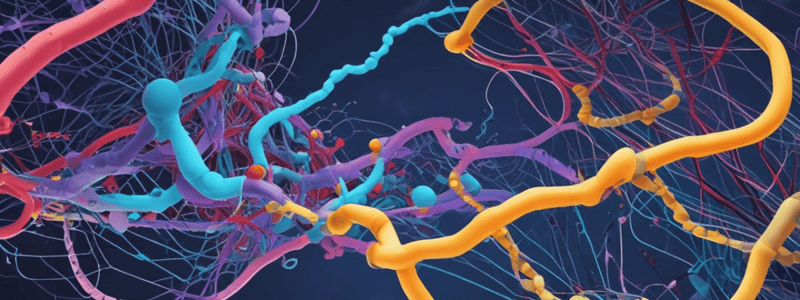Podcast
Questions and Answers
What is the main concept of the Michaelis-Menten Theory?
What is the main concept of the Michaelis-Menten Theory?
- The substrate induces conformational changes in the enzyme.
- The enzyme and substrate have a rigid structure.
- The enzyme and substrate fit together like a lock and key.
- The enzyme combines with the substrate to form an enzyme-substrate complex. (correct)
According to the Lock and Key Theory, what is the relationship between the enzyme and substrate?
According to the Lock and Key Theory, what is the relationship between the enzyme and substrate?
- The substrate induces conformational changes in the enzyme.
- The enzyme and substrate have a flexible structure.
- The enzyme and substrate have no specific binding site.
- The enzyme and substrate fit together like a lock and key. (correct)
What is the main limitation of the Lock and Key Theory?
What is the main limitation of the Lock and Key Theory?
- It does not explain the flexibility of enzymes. (correct)
- It does not explain the induced fit of enzymes.
- It does not explain the role of enzymes in diagnosis.
- It does not explain the binding of substrates to enzymes.
According to the Induced Fit Theory, what happens when the substrate binds to the enzyme?
According to the Induced Fit Theory, what happens when the substrate binds to the enzyme?
What is the analogy used to explain the Induced Fit Theory?
What is the analogy used to explain the Induced Fit Theory?
What is the clinical significance of enzymes in diagnosis?
What is the clinical significance of enzymes in diagnosis?
What is the name of the theory that states that the three-dimensional structure of the active site of the enzyme is complementary to the substrate?
What is the name of the theory that states that the three-dimensional structure of the active site of the enzyme is complementary to the substrate?
Who is the proposer of the Induced Fit Theory?
Who is the proposer of the Induced Fit Theory?
Flashcards are hidden until you start studying
Study Notes
Enzyme-ll: Theories of Enzyme Action
Michaelis-Menten Theory
- States that enzyme (E) combines with substrate (S) to form an enzyme-substrate (ES) complex
- ES complex breaks down to enzyme and product (P)
- Also known as the Enzyme-Substrate complex theory
Lock and Key Theory (Fischer's Template Theory)
- States that the three-dimensional structure of the active site of the enzyme is complementary to the substrate
- Enzyme and substrate fit each other like a lock and key
- Implies a rigid structure for enzymes, which cannot explain their flexibility
Induced Fit Theory (Koshland's Theory)
- Conformational changes occur at the active site of enzymes when combined with substrate
- Substrate binds to a specific part of the enzyme, leading to secondary binding and conformational changes
- Substrate induces conformational changes in the enzyme, similar to a glove fitting a hand
- Enzyme's active site changes shape to accommodate the substrate
Studying That Suits You
Use AI to generate personalized quizzes and flashcards to suit your learning preferences.




